Sweet Corn IPM Newsletter No. 9 – August 27, 2021
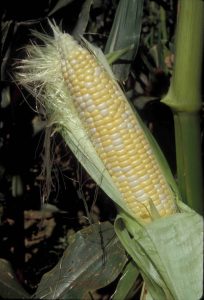
Sweet Corn IPM Newsletter No. 9 – August 27, 2021
Click on photos to enlarge.
FALL ARMYWORM NUMBERS RISING
Fall Armyworm and Corn Earworm Threaten Late Silking Corn.
SITUATION
Hot weather has pushed maturity of late planted fields, condensing the harvest season. Supply and quality look good for the upcoming holiday weekend at most farms, but the availability of late corn may be spotty. Both fall armyworm and corn earworm numbers rose in most locations this week, increasing the threat to fresh silking corn, and putting some farms on a shortened spray interval for the first time this season.
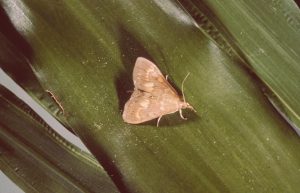
European corn borer:
No fields were over the 15% control threshold for larval feeding activity this week. European corn borer moth trap counts were over the spray threshold for silking corn of 5/week at sites in Dayton and Oxford. The Oxford site is not on a spray schedule for corn earworm, so a spray was recommended.

Corn earworm:
Pheromone trap moth captures increased in most, but not all locations this week. A 4-day spray schedule was recommended for Biddeford, Cape Elizabeth, Lewiston, New Gloucester, Sabattus, and one site in Wells. A 5-day spray schedule was recommended in Auburn, Wayne, and one Dayton site. Continue protecting silking corn until five to seven days before harvest, or once silks are thoroughly dry and brown.
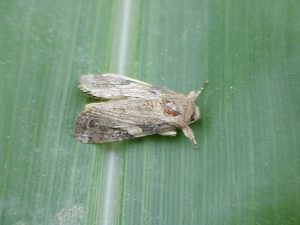
Fall armyworm:
Moths counts escalated significantly at most sites this week, with some of the highest counts of the season. These pose a significant threat to silking corn. Fields that are not under a spray schedule for earworm should be protected when the trap counts exceed the threshold of 3 moths per week. Sites that were over threshold this week include: Auburn, Biddeford, Bowdoinham, Cape Elizabeth, Dayton, Farmington, Monmouth, New Gloucester, Oxford, Wayne, and Wells. Sprays were recommended at sites where a spray schedule for corn earworm had not been recommended, including Bowdoinham, Farmington and Oxford. Larval feeding damage has been found in younger fields, exceeding the spray threshold of 15% of plants showing injury in Biddeford and Cape Elizabeth. Fall armyworm larvae can be difficult to control. Sprays are most effective if applied when larvae are still small, and have not yet burrowed into the whorls or ear channels where they can’t be reached. Make sure your sprayer is providing good coverage of the leaves and that the material is getting down into the whorls and emerging tassels. Consider using a spreader with the spray to improve distribution across the surface of the leaves.
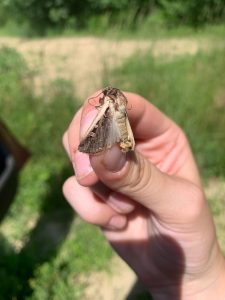
Western Bean Cutworm:
Moths continue to drop from earlier highs, ranging from 0 to 7. Sprays for fall armyworm and corn earworm should provide adequate protection for this insect as well.
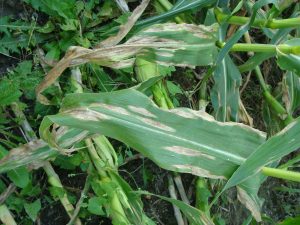
Northern Corn Leaf Blight:
Be on the lookout for this fungus disease, which has been reported in NJ this week. Gray to tan cigar-shaped lesions appear on the leaves and stalks, causing the leaves to die and dry up. Affected fields have reduced yield and poor ear quality. Management includes planting resistant varieties, rotating out of fields that have had the disease for at least one year, applying fungicides when symptoms are first noticed. For more information, including products and rates, consult the New England Vegetable Management Guide.
Sincerely,
David T. Handley
Vegetable & Small Fruit Specialist
Highmoor Farm Pest Management Unit
P.O. Box 179 17 Godfrey Drive
52 U.S. Route 202 Orono, ME 04473
Monmouth, ME 04259
207.933.2100 1.800.287.0279
| Location | CEW
Moths |
ECB
Moths |
FAW
Moths |
%Feeding
Damage |
Recommendations / Comments |
|---|---|---|---|---|---|
| Auburn | 4 | 0 | 52 | 2% | 5-day spray interval for silking corn |
| Biddeford | 9 | 0 | 85 | 47% | 4-day spray interval for silking corn |
| Bowdoinham | 1 | 2 | 31 | 7% | One spray for FAW on silking corn |
| Cape Elizabeth | 34 | 2 | 53 | 18% | 4-day spray interval for silking corn |
| Dayton I | 0 | 1 | 1 | 3% | No spray recommended |
| Dayton II | 4 | 6 | 60 | 13% | 5-day spray interval for silking corn |
| Farmington | 0 | 0 | 11 | One spray for FAW on silking corn | |
| Lewiston | 21 | 4 | 2 | 4-day spray interval for silking corn | |
| Monmouth | 1 | 4 | 100 | 3% | One spray for FAW on silking corn |
| New Gloucester | 42 | 1 | 58 | 0% | 4-day spray interval for silking corn |
| Oxford | 0 | 6 | 5 | 7% | One spray for FAW + ECB on silking corn |
| Sabattus | 9 | 0 | 2 | 3% | 4-day spray interval for silking corn |
| Wayne | 6 | 0 | 3 | 2% | 5-day spray interval for silking corn |
| Wells I | 22 | 1 | 9 | 2% | 4-day spray interval for silking corn |
| Wells II | 77 | 0 | 83 | 1% | 4-day spray interval for silking corn |
CEW: Corn earworm (Only fresh silking corn should be sprayed for this insect.)
ECB: European corn borer
FAW: Fall armyworm
| Moths caught per week | Moths caught per night | Spray interval |
|---|---|---|
| 0.0 to 1.4 | 0.0 to 0.2 | No spray |
| 1.5 to 3.5 | 0.3 to 0.5 | Spray every 6 days |
| 3.6 to 7.0 | 0.6 to 1.0 | Spray every 5 days |
| 7.1 to 91 | 1.1 to 13.0 | Spray every 4 days |
| More than 91 | More than 13 | Spray every 3 days |
Thresholds apply only to corn with exposed fresh silk. Lengthen spray intervals by one day if maximum daily temperature is less than 80°F.
European Corn Borer Thresholds
Whorl stage: 30% or more of plants scouted show injury.
Pre-tassel-silk: 15% or more of plants scouted show injury.
Silk: 5 or more moths caught in pheromone traps in one week.
IPM Web Pages:
Where brand names or company names are used, it is for the reader’s information. No endorsement is implied nor is any discrimination intended against other products with similar ingredients. Always consult product labels for rates, application instructions and safety precautions. Users of these products assume all associated risks.
The University of Maine is an equal opportunity/affirmative action institution.
